In the realm of vegetable gardening, the question of optimal spacing between tomato plants has long been a topic of interest and debate. This article aims to explore the factors that influence the distance at which tomatoes should be planted, considering aspects such as plant health, sunlight exposure, and potential pest and disease risks. By examining the intricate balance between maximizing yield and minimizing competition, this article aims to equip gardeners with valuable insights on how to best position their tomato plants for optimal growth and productivity.
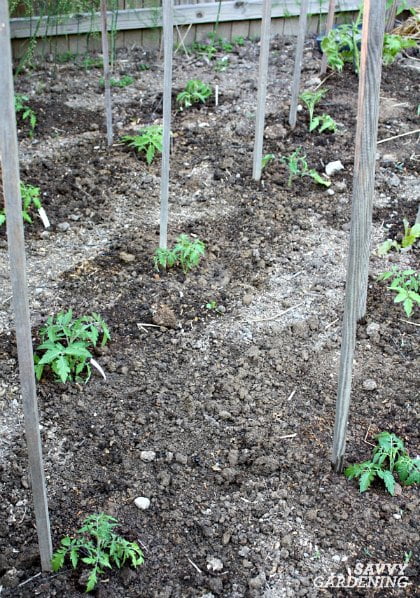
Choosing the Right Spacing for Tomato Plants
Growing tomatoes requires careful consideration of the spacing between plants. Choosing the appropriate spacing is essential for ensuring optimal growth, maximizing yield, and preventing diseases. Several factors should be taken into account when determining the recommended spacing for tomato plants, including understanding plant growth habits, considering container gardening options, and utilizing various gardening techniques. This article will explore different methods and guidelines to help you choose the right spacing for your tomato plants, taking into consideration various growing conditions and gardening preferences.
Traditional In-Ground Planting Spacing
Determining the Distance between Plants
When planting tomatoes in the ground, it is crucial to determine the appropriate distance between plants to allow for healthy growth. Typically, a spacing of 18-36 inches between plants is recommended. This range of spacing ensures sufficient airflow and prevents overcrowding, which can lead to increased disease susceptibility and poor fruit development.
Arranging Tomato Rows
Arranging tomato rows is equally important as determining the distance between plants. It is advisable to maintain a spacing of 3-4 feet between rows to provide ample space for tomato plants to spread out their foliage. This spacing facilitates better airflow, reduces the risk of diseases, and makes it easier to access the plants for maintenance tasks such as pruning and harvesting.
Accounting for Staking or Caging
If you plan to stake or cage your tomato plants, it is essential to consider the added space requirements. Staked or caged plants often require additional spacing between them to allow the support structures to be properly installed and to prevent overcrowding. Adding an extra 6-12 inches between plants can accommodate the staking or caging needs and ensure the plants have enough room for their growth.
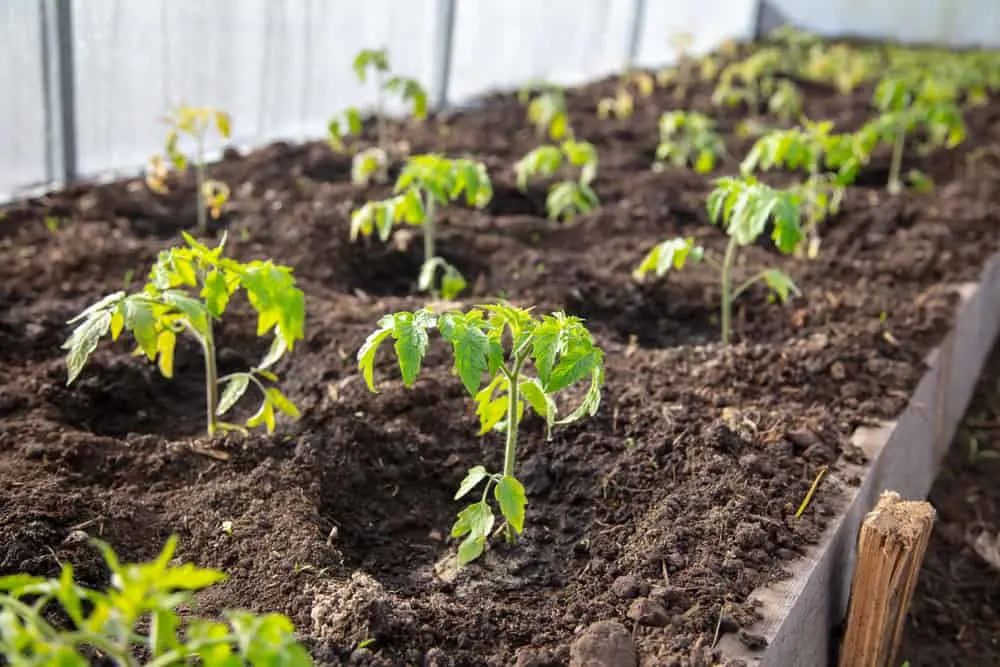
Square Foot Gardening Technique
Overview of Square Foot Gardening
Square foot gardening is a popular technique that maximizes the use of limited space while ensuring efficient plant growth. In this method, a raised bed or a grid is divided into square sections, each measuring one square foot. This technique offers several benefits, including reduced weed growth, improved water conservation, and better overall plant management.
Calculating Tomato Plant Density
When using square foot gardening for tomatoes, it is crucial to calculate the plant density per square foot accurately. Determining the appropriate density depends on the variety of tomato you are growing and its growth habit. As a general guideline, determinate tomato varieties can be spaced at 1 plant per square foot, while indeterminate varieties may require 1-2 plants per square foot. Adjusting the plant density within each square foot ensures proper growth, access to sunlight, and efficient use of space.
Benefits of Square Foot Gardening
Square foot gardening offers numerous advantages specifically for tomato cultivation. Firstly, the close spacing of plants maximizes the use of available space, resulting in higher vegetable yields per square foot. Additionally, the reduced weed growth in each square foot minimizes competition with tomato plants for nutrients and resources. The controlled environment of square foot gardening also allows for easier maintenance, watering, and pest control.
Raised Bed Gardening Spacing
Introduction to Raised Bed Gardening
Raised bed gardening involves creating garden beds that are elevated above the ground level. This method offers numerous benefits, including improved soil drainage, better soil structure, and easier access for maintenance and harvesting. When it comes to spacing tomato plants in raised beds, certain considerations need to be taken into account to ensure optimal growth and maximize yield.
Optimal Spacing for Tomato Plants
In raised bed gardening, it is recommended to space tomato plants approximately 24-36 inches apart. This spacing provides sufficient room for each plant’s root system to develop fully. Additionally, the wider spacing between plants allows for better airflow, reducing the risk of fungal diseases. By providing ample space, you give each tomato plant the opportunity to thrive without competing for sunlight, water, and nutrients, resulting in healthier and more productive plants.
Maximizing Yield in Raised Beds
To maximize yield in raised bed gardening, there are techniques that can be implemented in addition to proper spacing. For instance, interplanting with compatible companion plants such as basil or marigold can help ward off pests, attract beneficial insects, and improve overall plant health. Furthermore, incorporating trellising or staking systems allows for vertical growth, giving the tomato plants more space to spread out and receive ample sunlight, thus promoting higher fruit production.
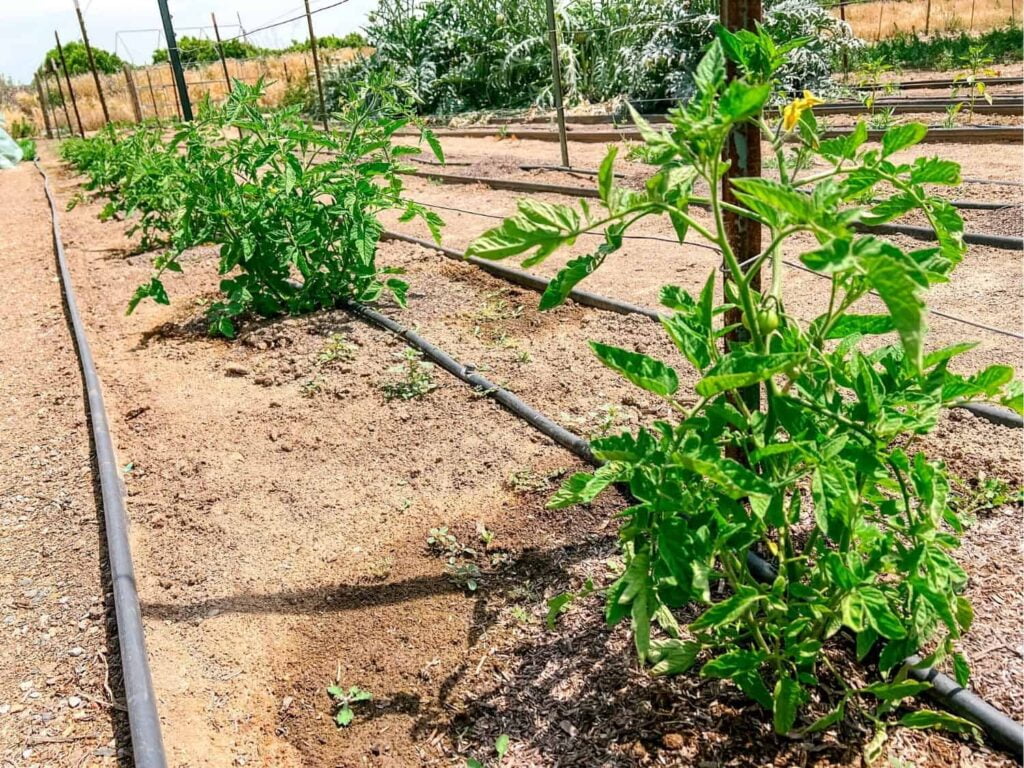
Intensive Gardening Techniques
Companion Planting with Tomatoes
Companion planting involves strategically planting complementary plants together to enhance growth, provide mutual benefits, and deter pests. When it comes to tomatoes, some suitable companion plants include basil, chives, and marigolds. These companion plants help repel harmful insects, enhance pollination, and improve overall garden biodiversity. Proper research and planning are essential when selecting companion plants to ensure compatibility and optimize growth.
Interplanting Tomatoes with Other Crops
Interplanting tomatoes with other crops is another effective intensive gardening technique. By utilizing the space between tomato plants, you can grow additional vegetables or herbs, maximizing the productivity of your garden. Consider planting quick-growing crops like lettuce, radishes, or spinach. These plants can be harvested before the tomato plants fully grow, providing an additional yield while making efficient use of space and resources.
Utilizing Succession Planting
Succession planting is the practice of planting crops in a series of staggered plantings throughout the growing season. By utilizing this technique with tomatoes, you can ensure a continuous supply of fresh tomatoes instead of a single harvest. Planting new tomato seedlings every few weeks extends the harvest period and maximizes the utilization of space in your garden. This method also reduces the risk of disease outbreaks affecting the entire crop at once and allows for better crop rotation practices.
High-Density Planting Methods
Close Spacing for Increased Yield
High-density planting involves reducing the spacing between plants to achieve a higher yield in a limited space. While increased plant density can lead to more competition for resources, it can also result in increased productivity if managed correctly. For tomatoes, a higher plant density often involves spacing plants 12-18 inches apart. This tighter spacing can increase the overall yield per area but may require more attention to proper watering, fertilization, and disease control.
Potential Challenges and Considerations
Although high-density planting can be advantageous, it presents some challenges. The increased density can lead to more competition for resources such as sunlight, water, and nutrients. This may require more frequent watering, more precisely balanced fertilization, and better disease management strategies. Adequate air circulation is also crucial when using high-density planting methods to prevent excessive moisture buildup, which can lead to fungal diseases.
Managing Foliage and Air Circulation
When implementing high-density planting methods, it is crucial to manage the foliage and ensure proper air circulation. Pruning excessive foliage and removing overcrowded branches can enable better air movement within the tomato plants, minimizing the risk of diseases. Additionally, using trellises, stakes, or cages to support the plants can help alleviate overcrowding and improve overall air circulation, enhancing plant health and fruit production.
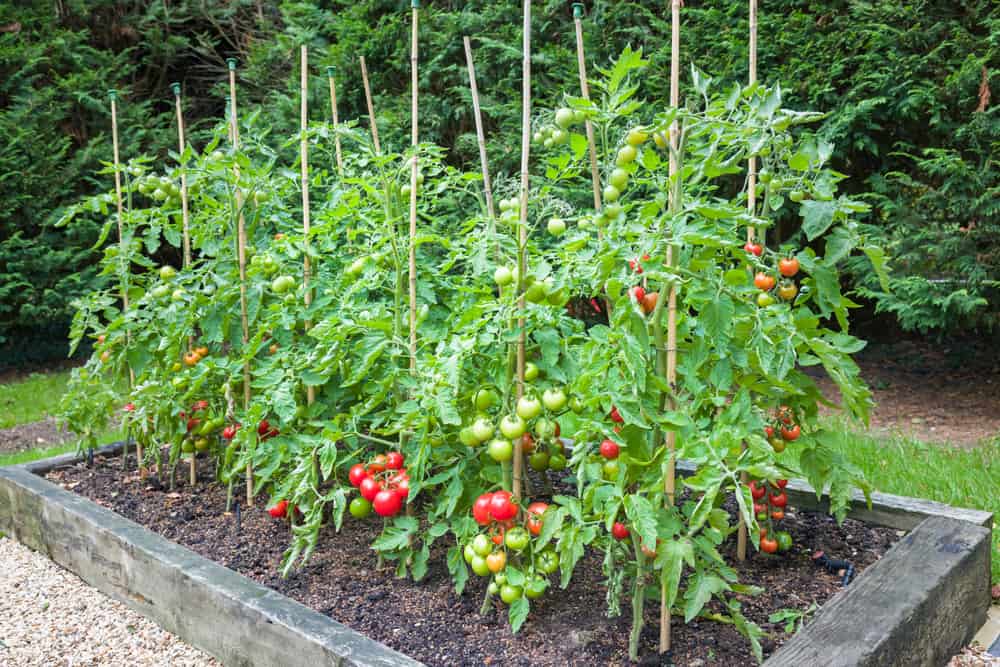
Vertical Gardening for Tomatoes
Using Trellises or Stakes
Vertical gardening is a technique that involves training tomato plants to grow upward instead of allowing them to sprawl on the ground. This method offers several benefits, including saving space, improving air circulation, and making harvesting easier. Utilizing trellises or stakes provides the necessary vertical support for tomato plants to grow upright.
Determining Plant Spacing for Vertical Growth
When growing tomatoes vertically, proper plant spacing is crucial to facilitate upward growth while ensuring adequate access to sunlight and airflow. It is recommended to space plants approximately 12-18 inches apart when using trellises or stakes. This spacing allows each plant to receive enough sunlight and reduces the risk of overcrowding, which can hinder fruit development.
Training and Supporting Tomato Vines
To successfully grow tomatoes vertically, proper training and support for the vines are essential. Regularly tying the tomato vines to the trellises or stakes as they grow helps guide their upward growth and prevents sprawling or tangling. It is also important to prune excessive foliage and suckers to encourage vertical growth, maximize airflow, and improve sunlight exposure throughout the plant.
Container Gardening and Pot Spacing
Choosing the Right Container Size
Container gardening offers flexibility and convenience for growing tomatoes in limited spaces such as balconies, patios, or small gardens. When selecting containers for tomato plants, it is crucial to choose the appropriate size to accommodate the plants’ root system and allow for optimal growth. A container with a minimum depth of 18-24 inches and a diameter of 14-18 inches is generally recommended for most tomato varieties.
Spacing Tomato Plants in Containers
Proper spacing is essential when growing tomatoes in containers to ensure each plant has sufficient space for root development and air circulation. In general, leave approximately 12-18 inches of space between tomato plants in containers. This spacing allows each plant to receive adequate sunlight, reduces the risk of diseases caused by excessive moisture buildup, and makes it easier to maintain individual plants.
Potting Mix and Nutrient Considerations
Container gardening requires careful consideration of the potting mix and nutrient availability to support healthy tomato plant growth. Ensure the potting mix is lightweight, well-draining, and rich in organic matter to promote root development and prevent waterlogged conditions. Regular fertilization with a high-quality, balanced tomato fertilizer is also essential as container-grown plants tend to deplete nutrients faster. Follow the fertilizer manufacturer’s recommendations for application rates and frequency for optimal plant growth.
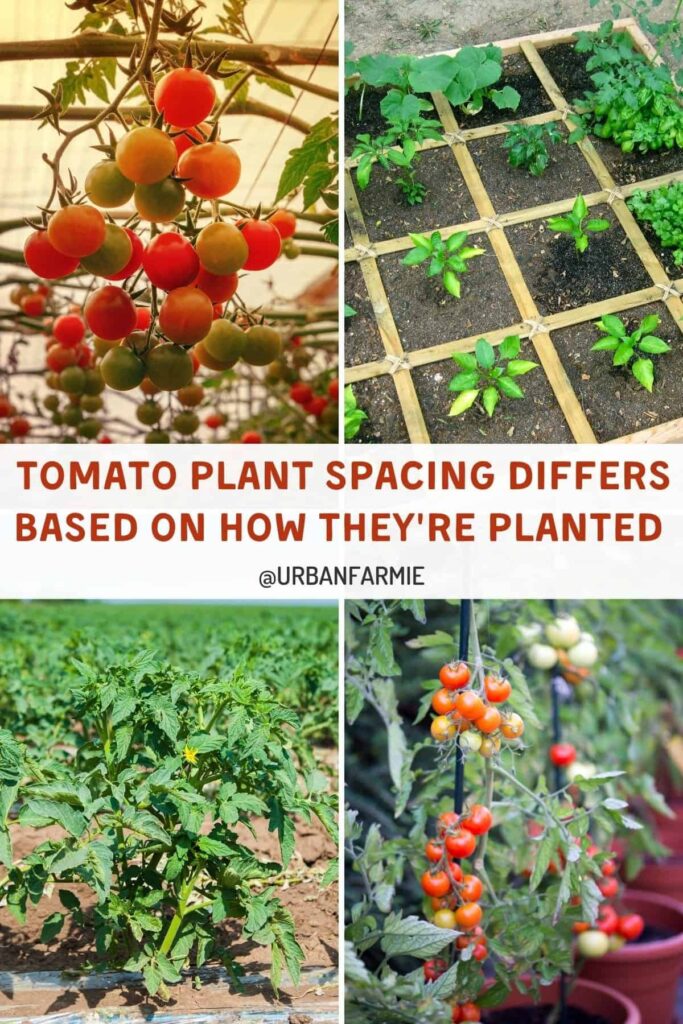
Spacing Guidelines for Determinate and Indeterminate Varieties
Understand Tomato Growth Habits
Understanding the growth habits of tomato varieties is crucial when determining the appropriate spacing between plants. Tomatoes are classified as either determinate or indeterminate, and their growth habits differ significantly.
Determinate tomatoes are compact and bushy, with a predetermined growth limit. These varieties tend to grow to a specific height and set fruit over a relatively short period. Indeterminate tomatoes, on the other hand, are vine-like and continue to grow and produce fruit until the first frost. The spacing requirements for these two types differ due to their growth patterns.
Recommended Spacing for Determinate Tomatoes
For determinate tomatoes, which have a more compact growth habit, a spacing of 18-24 inches between plants is generally sufficient. This spacing allows each plant to receive optimal sunlight and airflow, enabling the development of healthy fruit. The reduced spacing also promotes easier access for maintenance tasks such as pruning, harvesting, and pest control.
Recommended Spacing for Indeterminate Tomatoes
Indeterminate tomatoes, with their vining growth habit, require more space to accommodate their vigorous growth. It is recommended to space indeterminate tomato plants approximately 24-36 inches apart to allow for optimal air circulation, reduce the risk of disease, and ensure the plants have ample room to spread out and produce fruit. Additionally, providing adequate space between plants helps prevent the tangling of vines, making maintenance tasks more manageable.
Spacing Adjustments for Growing Conditions
Factors Affecting Spacing Needs
While general spacing guidelines can provide a starting point for planting tomatoes, specific growing conditions and factors may require adjustments to spacing. Several considerations should be taken into account, including climate, temperature, soil quality, and nutrient availability. These factors can significantly impact the growth, health, and overall productivity of tomato plants.
Adjusting for Climate and Temperature
In regions with a hot climate or during heatwaves, it may be necessary to increase the spacing between tomato plants to allow for better airflow and reduce heat stress. Similarly, in colder climates, spacing adjustments may be necessary to minimize the risk of frost damage. It is essential to monitor weather conditions and adjust plant spacing accordingly to ensure optimal growth and protect the plants from extreme temperatures.
Accounting for Soil and Nutrient Availability
Soil quality and nutrient availability differ from one garden to another. It is important to assess the soil’s fertility and supplement it with organic matter or suitable fertilizers as necessary. When soil nutrient levels are low, increasing the spacing between tomato plants can help reduce competition for nutrients, ensuring each plant has access to the necessary resources. Soil testing and regular monitoring of nutrient levels can guide these adjustments, ultimately promoting healthier plant growth and higher yields.
In conclusion, choosing the right spacing for tomato plants is crucial for their healthy growth, disease prevention, and maximizing yield. Traditional in-ground planting, square foot gardening, raised bed gardening, intensive gardening techniques, high-density planting methods, vertical gardening, and container gardening all offer various spacing considerations and techniques. By understanding the growth habits of tomato varieties and making adjustments to suit specific growing conditions, you can ensure successful tomato cultivation and a bountiful harvest. Remember to consider factors such as climate, temperature, soil fertility, and plant compatibility when determining the optimal spacing for your tomato plants. Happy gardening!



